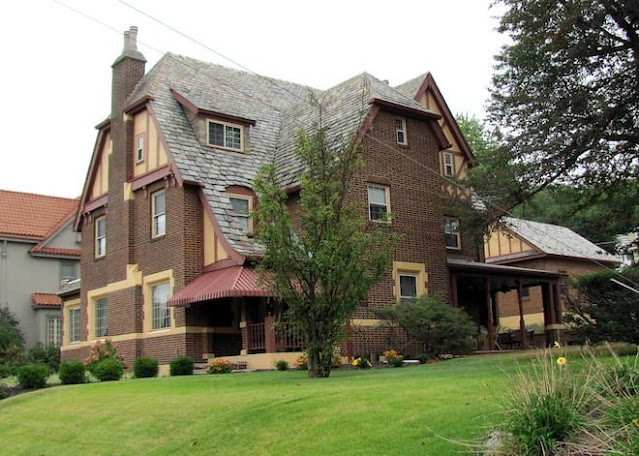Here are top 3 popular types of roof for your home.
1. Jerkinhead Roof
A jerkinhead roof incorporates aspects of a gable and hip roof into a single structure.
Clipped gable and English hip roofs are other names for jerkinhead roofs, which resemble traditional gable roofs but have been truncated at the end or have two shorter sides.
>> Related Post: Top benefits of hiring a professional roofing company.
This kind of roof all is often constructed so that the dormer windows on the upper floors are not obstructed by the clipped sides or hips.
A jerkinhead roof combines two styles – a gable and a hipped roof. Gable roofs feature two slopes, resembling a triangle. Hipped roofs feature four sloping sides that meet at a ridge or peak.
A jerkinhead roof looks like a gable roof on the sides, with two slopes that meet at a ridge. In the front and back is a hipped section much shorter than the sides, giving the roof an asymmetrical look.
Pros and Cons of a Jerkinhead Roof
The jerkinhead roof offers a traditional look but comes with pros and cons.
Pros:
Increased stability – The hipped ends of a jerkinhead roof provide more strength and resistance against high winds than a standard gable roof.
Doesn’t cut into top floor space – One of the downsides of a traditional hip roof is that it eliminates top floor space with its angles. A jerkinhead roof only features hipped sides on the front and back, allowing for a sizable top floor or attic.
>> Related Post: The Importance of Regular Maintenance for Office Roofing.
Less prone to leaks than hip roofs – Since the hipped sections of a jerkinhead roof are clipped, they have much shorter seams and are less likely to leak than a standard hip roof.
Aesthetics – Jerkinhead roofs give homes a traditional or historic look.
Cons:
Expensive to build – The jerkinhead roof will require more labor and material costs than a standard gable roof.
More complex repairs – The design of the jerkinhead roof makes them more challenging to access and repair.
2. Gambrel Roof
There are many similarities between mansard and gambrel roofs, sometimes known as barn-style roofs or barn-style roofs.
Mansard roofs have four sloping sides, while gambrel roofs only have two, resulting in a more triangular roof than a square or rectangular one.
The bottom slope of this roof all is almost vertical, but the higher slope is more gradual, including an attic, loft, or garret for additional storage or living space.
>> Related Post: The Benefits of Choosing One Roofing System for Your Home.
Used in Renaissance and Baroque French architecture, gable roofs are among the simplest in design. It is the classic-looking triangle you see in most kids’ drawings of a house.
Its design allows water to drain off. And since gable roofs have sharp angles, snow doesn’t pile on them.
They’re also one of the least expensive to build and replace.
Gambrel roofs, in terms of design, are also simple. They come to a point like a gable but have two slopes on each side. These roofs are great at maximizing space but look more decorative than a standard gable.
Gambrel roofs are also ideal for water drainage. But, because they have a shallow top slope, they give space for snow to pile up. In extreme circumstances, this can be too heavy a load for the roof.
They’re preconstructed, and builders assemble them in pieces. Since gambrel roofs cover a little more area, you can expect them to be more expensive than a gable roof.
3. Mansard Roof
There are four double sloping sides that meet to produce a low-pitched roof all in the center of the roof known as a "Mansard roof" or a "French roof," which was initially built by architect Francois Mansert.
Mansard roofs are commonly employed as a technique to increase the flexibility of a property because of the additional living space (referred to as a garret or loft) or attic storage they offer.
The mansard style makes maximum use of the interior space of the attic and offers a simple way to add one or more storeys to an existing (or new) building without necessarily requiring any masonry.
Often the decorative potential of the mansard is exploited through the use of convex or concave curvature and with elaborate dormer window surrounds.[citation needed]
One frequently seen explanation for the popularity of the mansard style is that it served as a method of tax avoidance.
One such example of this claim, from the 1914 book How to Make a Country Place, reads, "Monsieur Mansard is said to have circumvented that senseless window tax of France by adapting the windowed roof that bears his name."
>> Related Post: Why Precision Roofing in Houston is Crucial for Your Home?
This is improbable in many respects: Mansart was a profligate spender of his clients' money, and while a French window tax did exist, it was enacted in 1798, 132 years after Mansart's death, and did not exempt mansard windows.
Later examples suggest that either French or American buildings were taxed by their height (or number of storeys) to the base of the roof, or that mansards were used to bypass zoning restrictions.
This last explanation is the nearest to the truth: a Parisian law had been in place since 1783, restricting the heights of buildings to 20 metres (65 feet).
The height was only measured up to the cornice line, making any living space contained in a mansard roof exempt. A 1902 revision of the law permitted building three or even four storeys within such a roof.
Conclusion
Swadley Roof Systems offers the best roofing services in the Houston, Austin, San Antonio and Dallas area.
- Tel: 832-559-8463
- Email: info@swadleyroofsystems.com
- Location: 17413 FM 2920 Suite O Tomball, TX 77377
- Facebook: Fanpage Swadley Roof Systems
- Website: https://www.swadleyroofsystems.com/







0 Comments
Đăng nhận xét